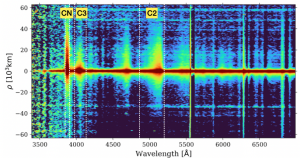Our colleagues, I. Mariblanca-Escalona and collaborators from the SciTechSS group have been carrying out a study on the activity of the Jupiter-family comet 7P/Pons-Winnecke during its 2021 apparition. Our team analysed visible imaging and long-slit spectrophotometry from the Calar Alto Observatory (Spain) to model the comet’s dust and gas emissions. We completed our dataset with three 𝑟-Sloan images observed with the Zwicky Transient Facility (ZTF).
For the dust study, we used a Monte Carlo method (Moreno 2022), which reproduced the comet’s observed isophotes, as seen below.

The comet’s dust production peaked at 83 kg/s about 15 days after perihelion, confirming an asymmetric activity pattern previously reported by other researchers. This tendency to exhibit maximum dust emission post-perihelion is typical among Jupiter-family comets. The particle terminal speed ranges from 3 m/s for 0.1 m particles to 23 m/s for 5 𝜇m particles.
Spectral observations also revealed that gas production was relatively low compared to other JFC comets. The following figure shows the optical fluorescent emission of some radicals in the coma of comet 7P on May 13. The nucleus is placed at 𝜌 = 0 km, the –y axis is the antisun direction, and the +y axis is the Sun direction. We can see CN and C₂ fluorescent emissions display asymmetries between the directions probed by the long-slit spectrophotometric observations: 
This asymmetric fluorescent emission is produced by an asymmetric production rate of those two species, while no such pattern could be undoubtedly confirmed for C₃. We calculate C₃/CN and C₂/CN production rate ratios, which indicate that 7P has a typical composition regarding the carbon-bearing species. However, according to the criteria of Cochran et al. (2012), the comet shows signs of being somewhat C₃-depleted, although this depletion does not fully justify the classification of comet 7P as carbon-depleted.
Our study suggests that 7P exhibits a dust-rich composition, with a dust-to-gas mass ratio of around 2. This slight dominance of dust production could be a sign that 7P is in an intermediate-aged stage.
Our findings contribute to a better understanding of 7P/Pons-Winnecke and its evolutionary state. This research also represents an important step for Irene Mariblanca-Escalona, as her first publication as a leading author. For more details, you can explore our recently published paper: https://doi.org/10.1093/mnras/staf370

